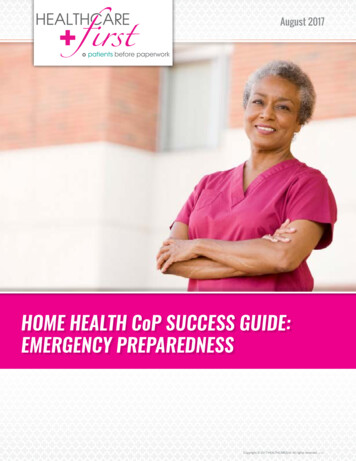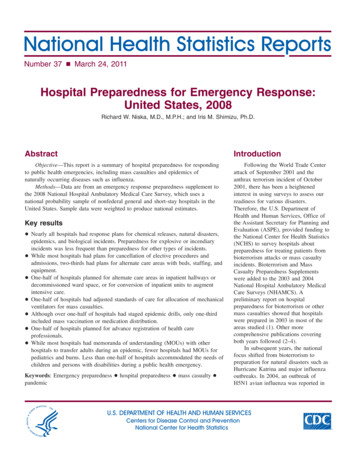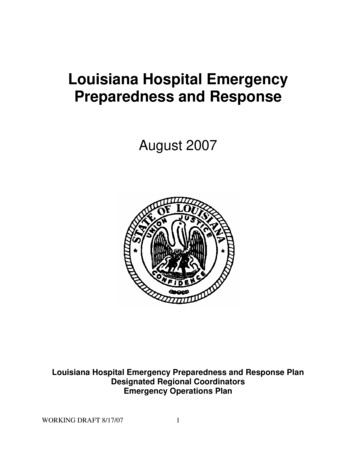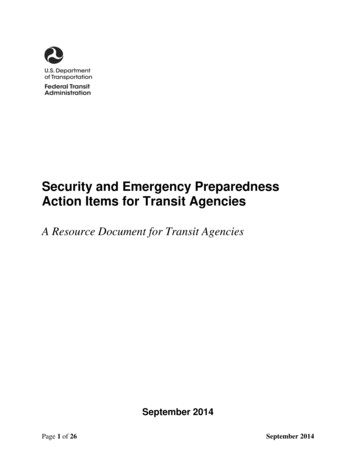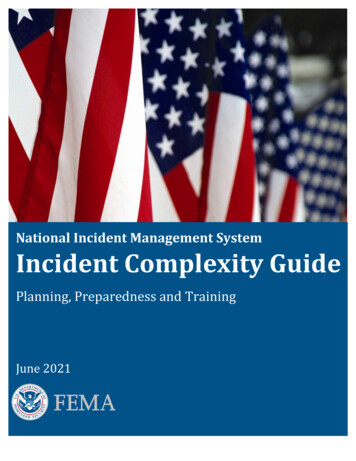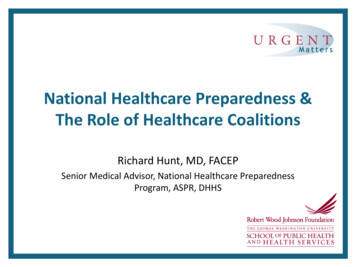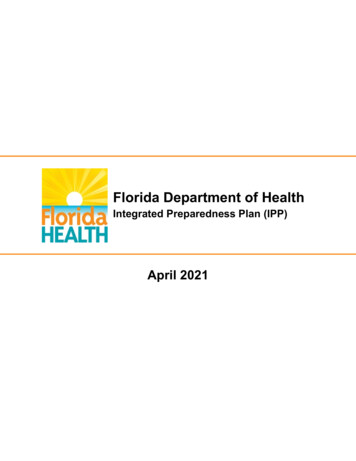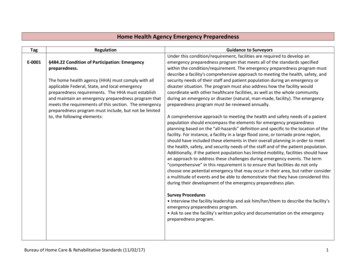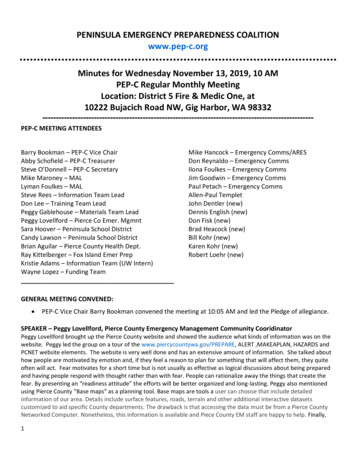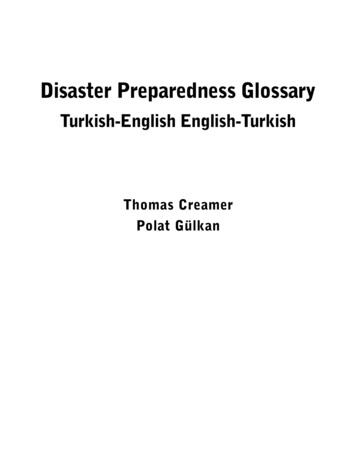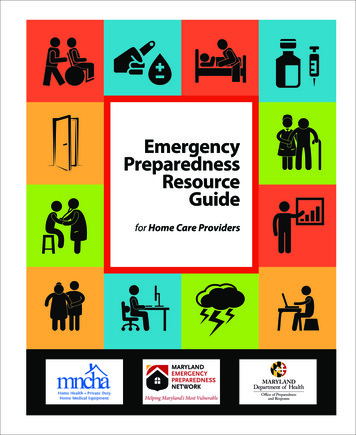
Transcription
EmergencyPreparednessResourceGuidefor Home Care Providers
Table of ContentsIntroduction . . . . . . . . . . . . . . . . . . . . . . . . . . . . . . . . . . . . . . . . . . . . . . . . . . . . . . . . . . . . . . . . . . . . . . . . . . . . . . . . . . . . . . . . . . . . . . . . 3Part 1: AssessmentsConducting a Hazard Vulnerability Assessment . . . . . . . . . . . . . . . . . . . . . . . . . . . . . . . . . . . . . . . . . . . . . . . . . . . . . . . . . . . .Exhibit A.1: Hazard Vulnerability Assessment Tool (sample) . . . . . . . . . . . . . . . . . . . . . . . . . . . . . . . . . . . . . . . . . . . . . . .Exhibit A.2: Hazard Vulnerability Assessment Tool (blank) . . . . . . . . . . . . . . . . . . . . . . . . . . . . . . . . . . . . . . . . . . . . . . . .Conducting a Home Care Emergency Preparedness Assessment . . . . . . . . . . . . . . . . . . . . . . . . . . . . . . . . . . . . . . . . . . .Exhibit B: Home Care Emergency Preparedness Assessment Tool . . . . . . . . . . . . . . . . . . . . . . . . . . . . . . . . . . . . . . .Patient Acuity Assessment . . . . . . . . . . . . . . . . . . . . . . . . . . . . . . . . . . . . . . . . . . . . . . . . . . . . . . . . . . . . . . . . . . . . . . . . . . . . . . . .Exhibit C: Patient Acuity/Risk Assessment Template . . . . . . . . . . . . . . . . . . . . . . . . . . . . . . . . . . . . . . . . . . . . . . . . . . . .5678899Part 2: Incident Command SystemIncident Command Overview . . . . . . . . . . . . . . . . . . . . . . . . . . . . . . . . . . . . . . . . . . . . . . . . . . . . . . . . . . . . . . . . . . . . . . . . . . . .Incident Management Team Roles and Responsibilities . . . . . . . . . . . . . . . . . . . . . . . . . . . . . . . . . . . . . . . . . . . . . . . . . . .Exhibit D: Incident Command System . . . . . . . . . . . . . . . . . . . . . . . . . . . . . . . . . . . . . . . . . . . . . . . . . . . . . . . . . . . . . . . . .Exhibit E: Incident Command Assignment List . . . . . . . . . . . . . . . . . . . . . . . . . . . . . . . . . . . . . . . . . . . . . . . . . . . . . . . .11131718Part 3: Business Continuity PlanningHome Care Continuity Planning Toolkit . . . . . . . . . . . . . . . . . . . . . . . . . . . . . . . . . . . . . . . . . . . . . . . . . . . . . . . . . . . . . . . . . .Exhibit F: Home Care Business Continuity Checklist . . . . . . . . . . . . . . . . . . . . . . . . . . . . . . . . . . . . . . . . . . . . . . . . . . .Business Impact Analysis Overview . . . . . . . . . . . . . . . . . . . . . . . . . . . . . . . . . . . . . . . . . . . . . . . . . . . . . . . . . . . . . . . . . . . . . .Exhibit G: Business Impact Analysis Template . . . . . . . . . . . . . . . . . . . . . . . . . . . . . . . . . . . . . . . . . . . . . . . . . . . . . . . . . .Exhibit H: Employee Contact Information Report . . . . . . . . . . . . . . . . . . . . . . . . . . . . . . . . . . . . . . . . . . . . . . . . . . . . . .Exhibit I: Emergency Contact List – External Resources . . . . . . . . . . . . . . . . . . . . . . . . . . . . . . . . . . . . . . . . . . . . . . . .Exhibit J: Business Record Location List . . . . . . . . . . . . . . . . . . . . . . . . . . . . . . . . . . . . . . . . . . . . . . . . . . . . . . . . . . . . . . .Exhibit K: Vendor List . . . . . . . . . . . . . . . . . . . . . . . . . . . . . . . . . . . . . . . . . . . . . . . . . . . . . . . . . . . . . . . . . . . . . . . . . . . . . . . . .Exhibit L: Information System Data Back-Up Plan . . . . . . . . . . . . . . . . . . . . . . . . . . . . . . . . . . . . . . . . . . . . . . . . . . . . . .Exhibit M: Information Systems Report . . . . . . . . . . . . . . . . . . . . . . . . . . . . . . . . . . . . . . . . . . . . . . . . . . . . . . . . . . . . . . . .Exhibit N: Information Systems Software List . . . . . . . . . . . . . . . . . . . . . . . . . . . . . . . . . . . . . . . . . . . . . . . . . . . . . . . . . .Exhibit O: Forms and Supplies . . . . . . . . . . . . . . . . . . . . . . . . . . . . . . . . . . . . . . . . . . . . . . . . . . . . . . . . . . . . . . . . . . . . . . . .Exhibit P: Insurance Contact List . . . . . . . . . . . . . . . . . . . . . . . . . . . . . . . . . . . . . . . . . . . . . . . . . . . . . . . . . . . . . . . . . . . . . .Exhibit Q: Event Log . . . . . . . . . . . . . . . . . . . . . . . . . . . . . . . . . . . . . . . . . . . . . . . . . . . . . . . . . . . . . . . . . . . . . . . . . . . . . . . . . .Exhibit R: Financial Tracker . . . . . . . . . . . . . . . . . . . . . . . . . . . . . . . . . . . . . . . . . . . . . . . . . . . . . . . . . . . . . . . . . . . . . . . . . . . .Exhibit S: Risk Management Plan . . . . . . . . . . . . . . . . . . . . . . . . . . . . . . . . . . . . . . . . . . . . . . . . . . . . . . . . . . . . . . . . . . . . .19202323242526272829303132333435Part 4: Emergency Plan by EventHazard Vulnerabilities . . . . . . . . . . . . . . . . . . . . . . . . . . . . . . . . . . . . . . . . . . . . . . . . . . . . . . . . . . . . . . . . . . . . . . . . . . . . . . . . . . .Bioterrorism . . . . . . . . . . . . . . . . . . . . . . . . . . . . . . . . . . . . . . . . . . . . . . . . . . . . . . . . . . . . . . . . . . . . . . . . . . . . . . . . . . . . . . . . . . . . .CDC Bioterrorism Agents . . . . . . . . . . . . . . . . . . . . . . . . . . . . . . . . . . . . . . . . . . . . . . . . . . . . . . . . . . . . . . . . . . . . . . . . . . . . . . . .Chemical Emergencies . . . . . . . . . . . . . . . . . . . . . . . . . . . . . . . . . . . . . . . . . . . . . . . . . . . . . . . . . . . . . . . . . . . . . . . . . . . . . . . . . .Civil Disturbance and Workplace Violence . . . . . . . . . . . . . . . . . . . . . . . . . . . . . . . . . . . . . . . . . . . . . . . . . . . . . . . . . . . . . . . .Communication Interruption . . . . . . . . . . . . . . . . . . . . . . . . . . . . . . . . . . . . . . . . . . . . . . . . . . . . . . . . . . . . . . . . . . . . . . . . . . . .Extreme Heat and Cold . . . . . . . . . . . . . . . . . . . . . . . . . . . . . . . . . . . . . . . . . . . . . . . . . . . . . . . . . . . . . . . . . . . . . . . . . . . . . . . . . .Fire Emergency . . . . . . . . . . . . . . . . . . . . . . . . . . . . . . . . . . . . . . . . . . . . . . . . . . . . . . . . . . . . . . . . . . . . . . . . . . . . . . . . . . . . . . . . . .Floods . . . . . . . . . . . . . . . . . . . . . . . . . . . . . . . . . . . . . . . . . . . . . . . . . . . . . . . . . . . . . . . . . . . . . . . . . . . . . . . . . . . . . . . . . . . . . . . . . .Hurricane . . . . . . . . . . . . . . . . . . . . . . . . . . . . . . . . . . . . . . . . . . . . . . . . . . . . . . . . . . . . . . . . . . . . . . . . . . . . . . . . . . . . . . . . . . . . . . .Influenza . . . . . . . . . . . . . . . . . . . . . . . . . . . . . . . . . . . . . . . . . . . . . . . . . . . . . . . . . . . . . . . . . . . . . . . . . . . . . . . . . . . . . . . . . . . . . . . .Pandemic Influenza . . . . . . . . . . . . . . . . . . . . . . . . . . . . . . . . . . . . . . . . . . . . . . . . . . . . . . . . . . . . . . . . . . . . . . . . . . . . . . . . . . . . .Exhibit T: Home Health Care Services Pandemic Influenza Planning Checklist . . . . . . . . . . . . . . . . . . . . . . . . . .37384042444647495153545658
Power Outage . . . . . . . . . . . . . . . . . . . . . . . . . . . . . . . . . . . . . . . . . . . . . . . . . . . . . . . . . . . . . . . . . . . . . . . . . . . . . . . . . . . . . . . . . . .Radiological Emergencies . . . . . . . . . . . . . . . . . . . . . . . . . . . . . . . . . . . . . . . . . . . . . . . . . . . . . . . . . . . . . . . . . . . . . . . . . . . . . . .Tornado . . . . . . . . . . . . . . . . . . . . . . . . . . . . . . . . . . . . . . . . . . . . . . . . . . . . . . . . . . . . . . . . . . . . . . . . . . . . . . . . . . . . . . . . . . . . . . . . .Winter Weather . . . . . . . . . . . . . . . . . . . . . . . . . . . . . . . . . . . . . . . . . . . . . . . . . . . . . . . . . . . . . . . . . . . . . . . . . . . . . . . . . . . . . . . . . .62636567Part 5: ExercisesTypes of Emergency Preparedness Exercises . . . . . . . . . . . . . . . . . . . . . . . . . . . . . . . . . . . . . . . . . . . . . . . . . . . . . . . . . . . . . . 69Exhibit U: Discussion-based Exercises . . . . . . . . . . . . . . . . . . . . . . . . . . . . . . . . . . . . . . . . . . . . . . . . . . . . . . . . . . . . . . . . . 69Exhibit V: Operations-based Exercises . . . . . . . . . . . . . . . . . . . . . . . . . . . . . . . . . . . . . . . . . . . . . . . . . . . . . . . . . . . . . . . . . 70Part 6: HIPAA and DisastersWhat Emergency Professionals Need to Know . . . . . . . . . . . . . . . . . . . . . . . . . . . . . . . . . . . . . . . . . . . . . . . . . . . . . . . . . . . . 71Part 7: Succession PlansDelegation and Communication . . . . . . . . . . . . . . . . . . . . . . . . . . . . . . . . . . . . . . . . . . . . . . . . . . . . . . . . . . . . . . . . . . . . . . . . . 77Exhibit W: Lines of Succession/Delegation of Authority . . . . . . . . . . . . . . . . . . . . . . . . . . . . . . . . . . . . . . . . . . . . . . . . . 78Exhibit X: Communication Succession Plan . . . . . . . . . . . . . . . . . . . . . . . . . . . . . . . . . . . . . . . . . . . . . . . . . . . . . . . . . . . . 80Part 8: Resource Contact InformationEmergency Management Agencies . . . . . . . . . . . . . . . . . . . . . . . . . . . . . . . . . . . . . . . . . . . . . . . . . . . . . . . . . . . . . . . . . . . . . . 812 Emergency Preparedness Resource Guide
IntroductionThe Maryland-National Capital Homecare Association (MNCHA), with support from the Maryland Departmentof Health (MDH) Office of Preparedness and Response, has designed this resource guide so that home careproviders can educate and prepare themselves, their patients, and their agencies for a wide-range of disastersituations. It is the hope of MNCHA that home care providers will use this resource guide as a starting point fordeveloping a specific disaster preparedness plan.The definition of vulnerable is any individual or group that has a diminished ability or capacity to anticipate,cope, resist or recover from a natural or manmade hazard. Home care providers are entrusted with the care andprotection of the most vulnerable residents of our state. As such, a lack of preparedness for a disaster couldresult in the home care provider itself being vulnerable. During a disaster, capacity – or the resources availableto the community to help cope and respond to the disaster – may be diminished. MNCHA aims to help homecare providers prepare for disasters so that together we can increase the capacity of home care providers toplay a major role in emergency preparedness and recovery.This resource guide is divided into eight sections:1. Assessments2. Incident Command System3. Business Continuity Planning4. Emergency Plan by Event5. Exercises6. HIPAA and Disasters7. Succession Plans8. Resource Contact InformationThere are many resources available to assist you in increasing your knowledge of emergency preparedness.We used some of these sources in building this resource guide. Information was gathered from the MDH Officeof Preparedness and Response, Occupational Safety Health Administration, Centers for Disease Control andPrevention, U. S. Department of Homeland Security, ASPR TRACIE, and the Federal Emergency ManagementAgency.MNCHA wishes to thank Barbara Citarella, President of RBC Limited Healthcare & Management Consultantsfor her expertise in making significant updates and revisions and converting this Manual to a Resource Guide.MNCHA wishes to thank MDH for providing input and Diane Link of BlackTree Healthcare Consulting for hercontribution to the development of the original content.We would also like to thank Chroma Design and Communications for their assistance with design andproduction management.We hope you will use this manual to be better prepared as a company – and to help your patients and theirfamilies become better prepared. As always, we encourage your feedback on this resource and your input intofuture initiatives.Sincerely,Dawn SeekExecutive DirectorMaryland-National Capital Homecare AssociationEmergency Preparedness Resource GuideIntroduction3
4 Emergency Preparedness Resource GuideIntroduction
Part 1:AssessmentsPart 1:Assessments
Part 1:Assessments
Part 1: AssessmentsConducting a HazardVulnerability AssessmentOverviewA Hazard Vulnerability Assessment (see Exhibit A) is a tool designed to help companies identify and evaluatetheir level of risk and preparedness for a variety of emergency or hazardous events. The assessment lists themost common weather-related events that may occur in our region based on research of prior weather eventsover the past ten years. The other events include potential hazards that agencies need to be prepared for. Thistemplate is designed with the ability to be customized based on your own assessment of your service area, yourcompany, and your hazard vulnerabilities.InstructionsEvaluate your company’s probability, vulnerability and preparedness for each event listed based on a threelevel scale.Probability – Rated based on the frequency or likelihood of an event occurring.3: Very likely event may occur (event every 1-3 years)2: Likely event may occur (event every 3-10 years)1: Unlikely event may occur (event was over 10 years)Vulnerability – Rated based on the degree with which your company will be impacted. Consider items suchas service disruption, infrastructure damage, health hazard, financial impact, and potential for life threateningincidents.3: Total Disruption – Inability to provide services, utilize facilities, loss of life2: Moderate Disruption – Inability to provide services, utilize facilities for short period of time1: Low Disruption – little or no impact on ability to provide services, utilize facilityPreparedness – Rated based on your agency’s experience in dealing with events of this nature or strength ofemergency preparedness plan to address these events. *Note the scale is in the opposite order from prior scale.1: Good – Plan is in place or agency has encountered event with successful outcome2: Fair – Plan is in place but could be improved, event occurred but agency faced challenges3: Poor – No plan in place or event occurred and agency was unable to overcome challengesOnce all areas are completed in the chart, multiply the ratings for each event area. The higher total scores foreach event will identify the events that have the highest risk and may need immediate organizational planning.Agencies should determine the total score for an event that is an acceptable risk for their agency.Emergency Preparedness Resource GuidePart 1: Assessments5
6 Emergency Preparedness Resource GuidePart 1: mentalEpidemic/Pandemic FluEpidemic/Pandemic DiseaseChemical IncidentNuclear IncidentAir Pollution/Air QualityMan Made DisastersCivil DisturbanceBomb ThreatTerrorist ThreatMass CasualtyWorkplace ViolenceActive ShooterOperationalElectrical Power FailureCommunication FailureWater FailureTransportationInformational System FailureNatural DisastersHeat EmergencyCold EmergencyXXXXXXXXXXXLikelyVery LikelyXX231XXXXXXXXXXXXXUnlikelyPROBABILITY LEVELExhibit A.1: Hazard Vulnerability Assessment sruption Disruption Disruption3VULNERABILITY oor3PREPAREDNESS nTOTALSCORE
Emergency Preparedness Resource GuidePart 1: Assessments7Natural DisastersHeat EmergencyCold pidemic/Pandemic FluEpidemic/Pandemic DiseaseChemical IncidentNuclear IncidentAir Pollution/Air QualityMan Made DisastersCivil DisturbanceBomb ThreatTerrorist ThreatMass CasualtyWorkplace ViolenceActive ShooterOperationalElectrical Power FailureCommunication FailureWater FailureTransportationInformational System FailureEVENTVery Likely3Likely21UnlikelyPROBABILITY LEVELExhibit A.2: Hazard Vulnerability Assessment Tool21TotalModerateLowDisruption Disruption Disruption3VULNERABILITY LEVELGood1Fair2Poor3PREPAREDNESS LEVELMultiplyeachcolumnTOTALSCORE
Conducting a Home CareEmergency Preparedness AssessmentOnce you have assessed your hazard vulnerability, you must evaluate your company’s preparedness status.You can use the tool provided in Exhibit B to complete this step.This quick assessment will help you identify your company’s preparedness in case of an emergency. This list isnot inclusive of all items an agency may need to assess when preparing an emergency plan. An agency needsto consider their unique differences and specialties.Exhibit B: Home Care Emergency Preparedness Assessment ToolYesNoDo you have access to updated patient census?Do you identify patients’ acuity/risk levels?Do you update patients’ acuity/risk levels?Do you have written emergency preparedness education for patients?Have you completed a hazard vulnerability assessment?Have you set up an incident command?Do you have an emergency preparedness plan and policy?Do you have a current list of employee contact information?Do you have your employees’ emergency contact information?Have you provided education to all staff on the agency’s emergency preparedness policy?Have you held an emergency preparedness drill?Have you identified your community emergency preparedness contacts?(See list in back of this manual)Have you communicated with your community emergency preparedness team?Do you have a plan for securing medical supplies during an extended emergency?Do you have a plan for transportation in case of emergency?Have you created a business continuity plan?If you answered no to any of these questions then NOW is the time to review, update or create a comprehensiveemergency preparedness manual.8 Emergency Preparedness Resource GuidePart 1: Assessments
Patient Acuity AssessmentAn important part of preparedness is knowing each patient’s status, physical needs, and the availability of acaregiver to assist in an emergency. Upon admission, each patient should have an acuity assessment completedand kept on file for easy access. Using acuity levels, patients should then be categorized in an acuity risk levelreport. This list should be updated frequently and be easily accessible. The following Patient Acuity AssessmentTemplate can be modified to fit the patient population that the organization serves.Exhibit C: Patient Acuity/Risk Assessment TemplatePatient Name / I.D.Caregiver:Address:Phone Number:Diagnosis:Case Manager/Assigned Staff:1. High Priority – Patient must have care. Patients in this priority level need uninterrupted services. In case of disasteror emergency, every possible effort must be made to see this patient. The patient’s condition is highly unstableand deterioration or inpatient admission is highly probable if patient is not seen. Examples include highly skilledwound care, unstable patients with no caregiver or informal support to provide care.2. M oderate Priority – Services may be postponed with telephone contact. A caregiver can provide basic care until theemergency situation improves. Patient’s condition is somewhat unstable, requires care but care can be postponedwithout jeopardy to the patient.3. L ow Priority – Patient may be stable and has access to informal resources to assist them. Patient can safely miss ascheduled visit safely with basic care provided by family or other support measures including the patient.Medical Procedures / zerTracheostomy CareNutritionEnteral Nutrition (Tube Feedings)Parental Nutrition (TPN)Meal PreparationNeeds Assistance to be FedEliminationColostomy/IleostomyUrinary Catheter (indwelling or intermittent)Dialysis in HomeDialysis at CenterToileting Assistance NeededIncontinentEmergency Preparedness Resource GuidePart 1: Assessments9
Medical Procedures / Treatments ty1-HighPriority2-ModeratePriority3-LowPriorityIn HomeRequiresElectricPortableMedicationOral Medication AssistanceIntravenous Medication ContinuousIntravenous Medication IntermittentWound CareBasic Wound CareComplicated Wound CareWound VacInfection - MRSA, VREADLs / Supervision / CommunicationBedboundRequires Assistance with TransferWheelchair DependentDementia/Alzheimer’s SupervisionBehavioral Health SupervisionAphasiaDeafnessNon-English LanguageOtherDisease Management AssessmentPalliative CareHospice CareTransport CarTransport WheelchairTransport AmbulanceDurable Medical EquipmentOxygenVentilator, Bipap, CpapSuctionNebulizerWalker, Crutches, CanesHospital BedSpecialty Air MattressHoyer LiftWheelchairMedical SuppliesAmount needed per day/weekOstomyCatheterGlucometerInsulin PumpsWound SuppliesOther10 Emergency Preparedness Resource GuidePart 1: Assessments
Part 2: IncidentCommand SystemPart 2:IncidentCommandSystem
Part 2: IncidentCommand System
Part 2: Incident Command SystemIncident CommandOverviewThe use of the Incident Command System (ICS) is a well-established emergency response protocol in military,public and private sectors. In 2004, the Homeland Security Presidential Directive-5 developed and implementedthe National Incident Management System (NIMS). The goal of NIMS is to develop a national template forpreparedness and response that incorporates government and nongovernment agencies to work togetherthrough collaboration of providers.Home care providers are unique in the health care setting in that they are focused in the community versus in aninstitution. The ability for home care providers to support vulnerable patients and the community emergencymanagement system requires an ICS that is designed so that all resources can integrate into the emergencyoperations structure with an established chain of command.The ICS features include the following:1. Common Terminology/Clear Text: The use of common terminology and the avoidance of using codes,slang or discipline-specific information allows for clear communication. Common terminology is used inthe ICS instead of organizational titles or roles.2. Modular Organization: The ICS structure starts at the top and expands downward as needed per event.The positions within the ICS that are needed are based on the extent or impact of the emergency event.3. Management by Objective: Emergency events are not “business as usual,” so clearly defined objectiveswill assist staff in focusing on their roles in an emergency response. Incident objectives are specific andstate what is to be accomplished, are measurable with a timeframe, are attainable and reasonable, andare evaluated to determine effectiveness of strategies or tactics. The incident objectives should be basedon a clear understanding of your organization’s policies.4. Incident Action Planning: The incident objectives are documented in the Incident Action Plan (IAP) andreflect the overall strategy for the incident management. The IAP is a written plan that enables staff totake action based on the incident objectives identified in the plan.5. Manageable Span of Control: The incident management should be effective and efficient, thus theincident managers should have responsibility for no more than 3 to 7 subordinates.6. Pre-Designed Incident Locations/Facilities: In the planning stage of ICS, a determination should bemade on coordinating sites, command posts, staging areas for staff and supplies, and evacuation plansfor office staff and patients.7. Resource Management: Resources are defined as either tactical or support. Tactical resources includestaff and equipment available for use in the response. Support resources are all other resources tosupport the event including food, equipment, supplies, vehicles, and communication tools. It isimportant to identify the location and availability of the resources not only within your agency butwithin your community or medical mutual aid system.8. Integrated Communication: The integrated communication includes the hardware (telephones, cellphones, radios, and Internet), the advance planning of the communication policy and plan, and lastlythe plan to share information internally and externally.Emergency Preparedness Resource GuidePart 2: Incident Command System11
9. Command Structure: ICS provides a common command structure that identifies core principles andan efficient chain of command. Unity of command dictates that each person within the structurereport to one supervisor. Single command exists when a single agency responds to the event; unifiedcommand structure is used when multiple agencies/disciplines are working together during theevent. An example of unified command would be during a weather emergency when the emergencymanagement incident commander and the agency incident commander work together to meet theincident objectives.Access information about how to receive formal ICS training at https://training.fema.gov/nims/.12 Emergency Preparedness Resource GuidePart 2: Incident Command System
Incident Management TeamRoles and ResponsibilitiesOverviewThe Incident Command System (ICS) is a management system, not an organizational chart. The incidentcommand functions are developed based on a number of principles of emergency management including: Every event requires certain management functions be performed: the evaluation of the currentincident, the development of incident objectives, the release of necessary resources and ongoingevaluation of the incident. Successful implementation of ICS requires defined incident commandfunctions. ICS organization and titles frequently do not correlate to daily operation responsibilities or functionswithin your company. This is done purposefully to avoid role and title confusion. Those assignedpositions in ICS come together during an event as the Incident Management Team (IMT) whose purposeis to respond to and recover from the event through a coordinated effort. Titles within the ICS should remain unchanged thus promoting interoperability between internal andexternal response partners. The IMT consists of command, gen
Using acuity levels, patients should then be categorized in an acuity risk level report . This list should be updated frequently and be easily accessible . The following Patient Acuity Assessment Template can be modified to fit the patient population that the organization serves . exhibit C: Patient Acuity/risk Assessment Template
